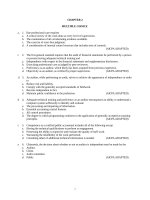Slide strategic core concept and analytical approach 5e by thomson chapter8
Bạn đang xem bản rút gọn của tài liệu. Xem và tải ngay bản đầy đủ của tài liệu tại đây (587.54 KB, 78 trang )
STRATEGY
Core Concepts and
Approaches
Concepts Analytical
and Analytic
Strategy – Core
Arthur
5th
Arthur A.
A. Thompson
Thompson
5th Edition
Edition (2018-2019)
(2018-2019)
Approaches
5e
The
The University
University of
of Alabama
Alabama
Authur A. Thompson, The University of
Alabama
CHAPTER 1 What Is Strategy and Why
CHAPTER
8
Is It Important?
Diversification
Strategies
An
An e-book
e-book published
published and
and distributed
distributed
by
byMcGraw
McGrawHill
Hill Education,
Education,Burr
Burr Ridge,
Ridge,Illinois
Illinois
Copyright
Copyright©©2018
2018 by
byArthur
ArthurA.
A.Thompson,
Thompson,Glo-Bus
Glo-Bus Software,
Software,Inc.
Inc.
All
All rights
rights reserved.
reserved.Not
Notfor
for distribution.
distribution.
I think our biggest achievement to date
has been bringing back to life an
inherent Disney synergy that enables
each part of our business to draw from,
build upon, and bolster the others.
Michael Eisner,
former CEO, Walt Disney Company
Copyright © 2018 by Glo-Bus Software, Inc.
8–2
Fit between a parent and its businesses
is a two-edged sword: A good fit can
create value; a bad one can destroy it.
Andrew Campbell, Michael Gould,
and Marcus Alexander
Copyright © 2018 by Glo-Bus Software, Inc.
8–3
Make winners out of every business
in your company. Don’t carry losers.
Jack Welch,
former CEO, General Electric
Copyright © 2018 by Glo-Bus Software, Inc.
8–4
Learning Objectives
1. Understand when to diversify and how to test whether a
move to diversify into a new business is sound.
2. Learn the strategic difference between related and
unrelated diversification strategies.
3. Gain an understanding of the pros and cons of related
diversification strategies.
4. Gain an understanding of the pros and cons of unrelated
diversification strategies.
5. Gain command of the analytical approaches to evaluating
a company’s diversification strategy.
6. Become familiar with a diversified company’s principal
strategic options after it has diversified.
Copyright © 2018 by Glo-Bus Software, Inc.
8–5
Chapter 8 Roadmap
What Does Crafting a Diversification Strategy Entail?
When and Why Diversification Makes Good Strategic
Sense
Choosing the Diversification Path:
Related versus
Unrelated Businesses
The Case for Diversifying into Related Businesses
The Case for Diversifying into Unrelated Businesses
Evaluating a Diversified Company’s Strategy—The Six
Analytical Steps
Copyright © 2018 by Glo-Bus Software, Inc.
8–6
What Is Meant by “Diversification”?
A firm is diversified when it operates in two or more lines of
business that are in distinctly different industries
Diversification complicates the strategy-making task
because it requires:
►
Assessing the multiple industry environments of a collection of
individual businesses
►
Developing a separate business strategy for each industry arena (or
line of business) in which the diversified firm operates
►
Devising a companywide (or corporate) strategy for improving the
attractiveness and performance of the company’s overall business
lineup and for making a rational whole out of its diversified collection
of individual businesses and individual business strategies
Copyright © 2018 by Glo-Bus Software, Inc.
8–7
What Does Crafting a Diversification
Strategy Entail?
Strategy-making in a diversified firm requires:
1. Picking new industries to enter and deciding whether to enter the
industry by start-up, acquisition, or a joint venture or strategic
alliance with another firm
2. Pursuing opportunities to leverage cross-business value chain
relationships and strategic fits into competitive advantage
3. Evaluating the growth and profitability prospects for each business,
establishing investment priorities for each business, and then using
these priorities to steer corporate resources to individual businesses
4. Initiating actions to boost the combined performance of the
corporation’s collection of businesses
Copyright © 2018 by Glo-Bus Software, Inc.
8–8
FIGURE 8.1 Identifying a Diversified Company’s Strategy
Copyright © 2018 by Glo-Bus Software, Inc.
8–9
When to Consider Diversifying
There’s no urgency for a single-business firm to diversify into other businesses
so long as it has ample opportunities for growth and profitability in its present
industry
►
But it is risky for a single-business firm to continue to remain in one industry when, for
whatever reason, its long-term prospects for continued good performance start to dim
A single-business firm becomes a prime candidate for diversifying when:
►
Conditions in its present industry turn sour and are expected to be long-lasting
►
There are opportunities to expand into industries whose technologies and products
complement its present business
►
Its current competencies and capabilities are key success factors and valuable
competitive assets for competing in another business
►
Diversifying into closely related businesses will reduce its costs
►
It has a powerful and well-known brand name that can be transferred to the products
of other businesses and help drive the sales and profits of such businesses to higher
levels
Copyright © 2018 by Glo-Bus Software, Inc.
8–10
Diversification Possibilities
A firm can diversify:
►
Into closely-related or totally-unrelated businesses
►
Its present revenue and earning base to a small extent
or to a major extent
►
Into a one or two large new businesses or a greater
number of small ones
►
By acquiring an existing firm in a business/industry it
wants to enter
►
By forming a subsidiary in promising industry
►
By forming joint ventures with other firms to enter new
businesses
Copyright © 2018 by Glo-Bus Software, Inc.
8–11
Core Concept
Creating added long-term value for shareholders
via diversification requires building a multibusiness
firm where the whole is greater than the sum of its
parts—such 1 + 1 = 3 effects are called synergy.
Copyright © 2018 by Glo-Bus Software, Inc.
8–12
Will Diversification Produce Added LongTerm Value for Shareholders?
The Industry
Attractiveness Test
The Cost-of-Entry
Test
Diversifying in Ways
That Build Long-Term Value
for Shareholders
The Better-Off
Test
Copyright © 2018 by Glo-Bus Software, Inc.
8–13
Moves to Diversify into a New Business
Should Pass Three Tests
To produce added long-term economic value for
shareholders, diversifying must pass three tests:
1. Industry Attractiveness Test
• Industry conditions must be conducive to good profitability
2. Cost-of-Entry Test
• High cost of entering cannot spoil the profit opportunities
3. Better-Off Test
• Diversifying must offer potential for the firm’s businesses to
perform better together under a single corporate umbrella than
they would perform as independent stand-alone businesses
Copyright © 2018 by Glo-Bus Software, Inc.
8–14
Why The “Better-Off” Test Is So Important
Creating added long-term value for shareholders via diversification
requires building a multi-business firm where the whole is greater
than the sum of its parts.
Suppose Firm A diversifies by purchasing Firm B in another industry.
►
If A and B’s consolidated future profits are no greater than what each could
have earned on its own, then A’s diversification produces a 1 + 1 = 2 result
that does not create added value because A’s shareholders could have
achieved the same 1 + 1 = 2 result by merely purchasing stock in B.
Rule
Diversification
Diversification does
does not
not produce
produce added
added long-term
long-term value
value
for
for shareholders
shareholders unless
unless itit produces
produces aa 11 ++ 11 == 33 effect
effect
where
where the
the firm’s
firm’s different
different businesses
businesses perform
perform better
better together
together
than
than they
they would
would as
as independent
independent enterprises.
enterprises.
Copyright © 2018 by Glo-Bus Software, Inc.
8–15
Choosing the Diversification Path: Related
versus Unrelated Businesses
Related Diversification
Unrelated Diversification
Involves diversifying into
businesses whose value
chains possess
competitively valuable
“strategic fits” with the
value chain(s) of the
firm’s present
business(es)
Involves diversifying into
businesses having no
competitively valuable
value chain match-ups or
strategic fits with the
value chain(s) of the
firm’s present
business(es)
Copyright © 2018 by Glo-Bus Software, Inc.
8–16
FIGURE 8.2 The Three Fundamental Strategy Alternatives
for Pursuing Diversification
Copyright © 2018 by Glo-Bus Software, Inc.
8–17
Core Concept
Strategic fit exists when the value chains of different
businesses present opportunities for cross-business
resource transfer, lower costs through combining the
performance of related value chain activities, crossbusiness use of a potent brand name, and/or crossbusiness collaboration to build new or stronger competitive
capabilities.
Capturing such opportunities puts sister businesses
in position to perform better financially as part of the
same company than they could have performed as
independent enterprises, thus producing the 1 + 1 = 3
benefits that boost shareholder value.
Copyright © 2018 by Glo-Bus Software, Inc.
8–18
The Case for Diversifying into
Related Businesses
What makes related diversification an attractive strategy is the
opportunity to convert cross-business strategic fits into a competitive
advantage over business rivals whose operations do not offer
comparable strategic fit benefits
The greater the relatedness among a diversified firm’s sister
businesses, the bigger a firm’s window for converting strategic fits into
competitive advantage via:
►
Transfer of competitively valuable expertise, technological know-how, or
other resources from one business to another
►
Combining the related value chain activities of separate businesses into a
single operation to achieve lower costs.
►
Cross-business use of a well-respected brand name
►
Cross-business collaboration to create altogether new competitively valuable
resources and capabilities
Copyright © 2018 by Glo-Bus Software, Inc.
8–19
FIGURE 8.3 Related Businesses Possess Related Value Chain Activities and
Competitively Valuable Cross-Business Strategic Fits
Copyright © 2018 by Glo-Bus Software, Inc.
8–20
Core Concept
Economies of scope stem from successful managerial
efforts to capture cost-saving strategic fits along the value
chains of related businesses.
►
Economies of scope can be achieved only if a diversified firm
operates in two or more related businesses with cost-related
strategic fits in one or more value chain activities.
►
Often these cost-saving efficiencies are captured by combining
the cost-related value chain activities of related businesses into a
single, more cost-efficient operation.
►
When economies of scope exist, sister businesses can be
operated more cost-efficiently as part of the same firm than they
could operate as stand-alone businesses.
Copyright © 2018 by Glo-Bus Software, Inc.
8–21
Economies of Scope Are Different
from Economies of Scale
Economies of scope are achieved by capturing cost-saving strategic
fits along the value chains of related businesses; examples of such
cost-saving efficiencies include:
► Production-related strategic fits that enable two or more related businesses to use the
same manufacturing facility to perform their production activities (using a single plant
is likely to be more cost-effective than having multiple plants) and/or
► Distribution-related strategic fits that enable two or more related businesses to share
use of the same distribution centers (utilizing a single distribution center is cheaper
than having multiple distribution centers) and/or
► Sales- and customer-related strategic fits that enable two or more related businesses
to use a common sales force to sell their products to customers (a single sales force
is more cost-efficient than having separate sales forces) and/or
► The ability of two or more related businesses to share use of the same administrative
infrastructure and thus spread admin costs over a bigger sales volume
Economies of scale are cost savings that occur because a large-scale
operation is more cost-efficient than a small-scale operation
Copyright © 2018 by Glo-Bus Software, Inc.
8–22
Why Achieving Economies of Scope in Related
Businesses Is Competitively Valuable
The greater the cost-savings associated with costrelated strategic fits among the value chains of
sister businesses, the greater the potential for a
related diversification strategy to yield a low-cost
competitive advantage over
►
Undiversified competitors
►
Competitors whose own diversification efforts
do not offer equivalent cost-saving benefits
Copyright © 2018 by Glo-Bus Software, Inc.
8–23
Strategic Fit and Competitive Advantage: The Keys to
Added Profitability and Gains in Shareholder Value
Diversified firms having sister businesses with multiple strategic fits
among their value chain activities have a larger opportunity window for
cross-business resource transfer, cost reduction, cross-business use of
a respected and potent brand name, and/or cross-business
collaboration to:
►
Enhance the overall competitive strength of the various sister businesses
►
Boost the profitability and performance of the firm’s collection of related
businesses
►
Achieve a competitive advantage over rivals whose own operations
do not offer equivalent strategic fit benefits
Such strategic-fit benefits can be substantial and capturing
them are what enables a firm pursuing related diversification
to achieve 1 + 1 = 3 or better financial performance and
to enhance shareholder value.
Copyright © 2018 by Glo-Bus Software, Inc.
8–24
The Case for Diversifying into
Unrelated Businesses
Unrelated diversification strategies involve
►
►
►
►
Entering any industry and operating any business where
there is opportunity to realize consistently good financial
results
No deliberate effort to diversify into businesses with
strategic fits
Acquiring an established company rather than forming a
start-up subsidiary or collaborating in a joint venture to
get into a new business
An acquisition passing both the industry attractiveness
and cost-of-entry tests and having good prospects for
financial performance
Copyright © 2018 by Glo-Bus Software, Inc.
8–25









